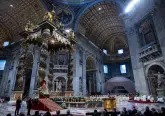After Nantes cathedral fire, volunteer detained but not called a suspect
CNA Staff, Jul 19, 2020 / 02:26 pm MT (CNA).- A 39-year-old cathedral volunteer has been detained as part of the arson investigation after a major fire at the Cathedral at Nantes on Saturday. French authorities warned against any “premature” judgment of the detained man.
“We must remain careful as to the interpretation of this police custody. It’s a normal procedure,” public prosecutor Pierres Sennès said Sunday, according to BBC News.
The July 18 fire is believed to be arson, said Sennes. There were three fires started at the site. The volunteer was responsible for locking the cathedral on Friday night. Investigators want “to clarify certain elements of this person’s schedule,” the prosecutor told Agence France Presse.
Sennes said “any interpretation which could implicate this person in the commission of the facts is premature and hasty.”
Firefighters were called to the cathedral, which dates from the 15th century, at 7:44 a.m. On Saturday, according to the French outlet BFM TV. Over 100 firefighters were at the scene and saved the main structure. The Diocese of Nantes said there was significant damage to the cathedral’s 16th century rose window and to the choir organ. Several priceless artifacts were also destroyed in the blaze.
There was no sign of a break-in. One of the fires could be linked to an “electric counter,” and investigators consider a short circuit to be another possible cause, the French newspaper Le Parisien reports.
The detained man, a refugee from Rwanda, was not named. Quentin Chabert, his lawyer, said there is “nothing at this stage to link my client to the fire.” He said the investigation must proceed “with respect for everyone’s rights and in particular those of my client.”
A cathedral staffer strongly rejected the possibility the man was linked to the fire.
“I don’t believe for a second that he could have set the cathedral on fire. It’s a place he adores,” Jean-Charles Nowak, a clerk at the cathedral, told the French newspaper Le Figaro.
Nowak described the detained volunteer as “a man of duty.” He had left Rwanda several years ago, where he “suffered a lot.” The volunteer, who has health problems, has been in discussions with local officials about extending his visa.
Fire Chief Laurent Ferlay told French television station BFM July 18 the damage to the Cathedral of St. Peter and St. Paul of Nantes “is concentrated on the organ, which seems to be completely destroyed. Its platform is very unstable and could collapse.”
He said the fire was not as severe as that which struck the Cathedral of Notre Dame 15 months ago and the damage is less extensive.
French president Emmanuel Macron on Saturday praised the work of firefighters on Twitter. “Support to our firefighters who take all risks to save this Gothic gem of the city of the Dukes,” he said, using a common honorific name for Nantes.
The Nantes cathedral was damaged by Allied bombing in 1944. The roof of the Gothic-style cathedral was previously destroyed in a large fire in 1971, after which the cathedral received an extensive restoration.
The Diocese of Nantes said July 18 the cathedral is “an architectural masterpiece” and “above all the mother church of the diocese.”
Vandalism and attacks on Christian churches in France have shocked Catholics, and prompted fears of deliberate conspiracy to intimidate and destroy, but crimes of that nature in France have not been shown to be the result of any coordinated campaign or, even of shared motives.
American journalist and author Richard Bernstein reflected on attacks and vandalism of French churches in a July 2019 essay for RealClearInvestigations titled “Anti-Christian Attacks in France Quietly Quadrupled. Why?”
Of identified perpetrators of anti-Christian attacks, more than 60 percent are minors. Many perpetrators “appear to be disaffected young people, or the psychologically disturbed or homeless, rather than members of organized groups advancing a political agenda,” Bernstein said.
The Conference of French Bishops said there were 228 “violent anti-Christian acts” from January to March 2019.
In 2018, French police reported 129 thefts and 877 incidents of vandalism at Catholic sites, mostly churches and cemeteries. Such attacks quadrupled in number from 2008 to 2019.
While France has suffered more such attacks than any other country in Europe, numbers have increased across Europe.
Archbishop Georges Pontier of Marseille, head of the French bishops’ conference, speaking to the magazine Le Point, warned against developing “a discourse of persecution.”
While some commentators say anti-Christian sentiment drives the attacks, others say a “loss of the sense of the sacred” is to blame, Bernstein reported.
The April 15, 2019 fire at the Cathedral of Notre-Dame shocked the world, as the 19th-century roof and spire were destroyed, though the structure was saved from collapse.
As soon as the fire was reported, social media influencers and others, often with no presence on the scene, spread speculation, rumors and even hoaxes claiming that the fire was an act of terrorism. Anonymous internet accounts as well as right-wing activists, nationalists, and white supremacists used the event to fan anti-Muslim sentiment, NBC News reported in April 2019.
Investigators of the Notre Dame fire have been unable to access the part of the structure where they believe the blaze began. They have found no evidence of an intentional fire and have been proceeding on the theory it was accidentally caused by an electrical short circuit or an improperly extinguished cigarette.
In the United States, some Catholics are on edge after a spate of attacks on churches and Catholic statues.
In Los Angeles, a major fire at the historic church at the San Gabriel Mission is being investigated for arson by local and federal authorities. Investigators have yet to determine the cause of a July 11 fire that destroyed the 249-year-old church’s roof and much of the historic church building. Because the mission church was under renovation, many of its historic and devotional objects had been removed, and were not inside when the building burned.
The fire also comes after numerous statues of St. Junipero Serra have been torn down in California: at the state capitol in Sacramento, in Los Angeles, and in San Francisco, while protestors have called for similar statues to be moved or torn down in other cities. While Serra, a Franciscan missionary priest, is regarded as a founder of California and an evangelist to indigenous people, some critics say he was complicit in human rights abuses in the eighteenth century. His supporters say Serra defended the rights and dignity of native people.
Serra specifically advocated for the rights of Native peoples, at one point drafting a 33-point “bill of rights” for the Native Americans living in the mission settlements. He walked all the way from California to Mexico City to present it to the viceroy. Many of the Natives he converted wept and mourned him upon his death in 1784.
Pope Francis canonized Serra in Washington, D.C. on Sept. 23, 2015, saying that “Junípero sought to defend the dignity of the native community, to protect it from those who had mistreated and abused it.”
Also in July at Queen of Peace Catholic Church in Ocala, Florida, a man crashed a minivan into the church and then lit it on fire with gasoline while people were inside preparing for morning Mass. A 24-year-old man was apprehended by police and charged with attempted murder, arson, burglary, and evading arrest.
According to local media, the man told police he has been diagnosed with schizophrenia but is not currently taking prescribed medication. He was previously arrested in 2019 for swinging a crowbar at a woman.













